

Gender and Society: A Matter of Nature or Nurture? "Men have always been afraid that women could get along without them.

" --Margaret Mead. Home - Databases by Subject - Library Guides at Monash University. Australian Bureau of Statistics, Australian Government. SBS On Demand, news, sport, food, movies. Sociology Central. Search Tips. Functionalism. Functionalism is a theory about the nature of mental states.

According to functionalism, mental states are identified by what they do rather than by what they are made of. This can be understood by thinking about artifacts like mousetraps and keys. In particular, the original motivation for functionalism comes from the helpful comparison of minds with computers. But that is only an analogy. The main arguments for functionalism depend on showing that it is superior to its primary competitors: identity theory and behaviorism. Table of Contents 1. Functionalism is a theory about the nature of mental states. 2. Consider, for example, mouse traps. Contrast mouse traps with diamonds. These examples can be used to explain the core idea of functionalism. Three Major Perspectives in Sociology.
Sociology's Four Theoretical Perspectives: Structural-Functional, Social Conflict, Feminism & Symbolic Interactionism. Sociology. Masculinities. To speak of masculinities is to speak about gender relations.
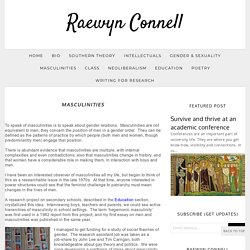
Masculinities are not equivalent to men; they concern the position of men in a gender order. They can be defined as the patterns of practice by which people (both men and women, though predominantly men) engage that position. Functionalism. Gender inequality in popular films. Gender Inequality in 500 Popular Films Smith 2013. 9 Depressing Facts From the Latest Women in Media Report. Women are inching towards media equality, but it’s slow going.
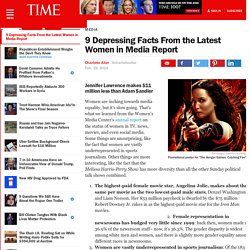
That’s what we learned from the Women’s Media Center’s annual report on the status of women in TV, news, movies, and even social media. Some things are unsurprising, like the fact that women are vastly underrepresented in sports journalism. Other things are more interesting, like the fact that the Melissa Harris-Perry Show has more diversity than all the other Sunday political talk shows combined. The highest-paid female movie star, Angelina Jolie, makes about the same per movie as the two lowest-paid male stars, Denzel Washington and Liam Neeson. Her $33 million paycheck is dwarfed by the $75 million Robert Downey Jr. rakes in as the highest-paid movie star for the Iron Man movies.
Inequalityprojects - Gender Inequality in the Media. Gender Inequality in the Media:Athletic Coverage in the Media: Media coverage of sports relies on a multitude of factors to enable the sports industry to be effective in America.
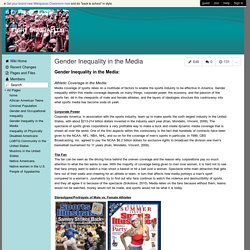
Gender inequality within this media coverage depends on many things; corporate power, the economy, and the passion of the sports fan. dd in the viewpoints of male and female athletes, and the layers of ideologies structure this controversy into what sports media has become soda oh yeah.Corporate Power Corporate America, in association with the sports industry, team up to make sports the sixth largest industry in the United States, with about $213-214 billion dollars invested in the industry each year (Kian, Mondello, Vincent, 2009).
The spectacle of sports gives corporations a very profitable way to make a buck and create dynamic media coverage that is shown all over the world. Gender Equality in the Media: The New Social Movement. Artwork by Jessica Bishop; Infographics by Erin Ford “The media is the message and the messenger, and increasingly a powerful one,” says Patricia Mitchell, the former president and CEO of PBS [4].
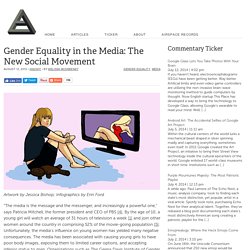
By the age of 10, a young girl will watch an average of 31 hours of television a week [1] and join other women around the country in comprising 52% of the movie-going population [5]. Unfortunately, the media’s influence on young women has yielded many negative consequences. The media has been associated with causing young girls to have poor body images, exposing them to limited career options, and accepting inferior status to men. Have We Achieved Gender Equality In The Media? 2013 was a great year for women in the Walkleys.
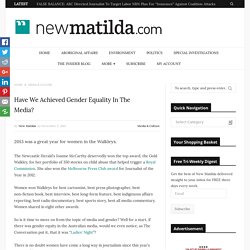
The Newcastle Herald’s Joanne McCarthy deservedly won the top award, the Gold Walkley, for her portfolio of 350 stories on child abuse that helped trigger a Royal Commission. She also won the Melbourne Press Club award for Journalist of the Year in 2012. Women won Walkleys for best cartoonist, best press photographer, best non-fiction book, best interview, best long-form feature, best indigenous affairs reporting, best radio documentary, best sports story, best all media commentary.
Women shared in eight other awards. Family Matters - Issue 93 - Greater gender equality. There remain persistent gender differences in economic outcomes throughout the world.
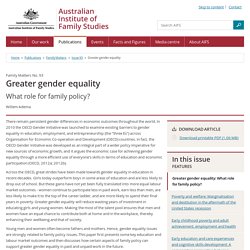
In 2010 the OECD Gender Initiative was launched to examine existing barriers to gender equality in education, employment, and entrepreneurship (the "three Es") across Organisation for Economic Co-operation and Development (OECD) countries. In fact, the OECD Gender Initiative was developed as an integral part of a wider policy imperative for new sources of economic growth, and it argues the economic case for achieving gender equality through a more efficient use of everyone's skills in terms of education and economic participation (OECD, 2012a; 2012b).
Across the OECD, great strides have been made towards gender equality in education in recent decades. Girls today outperform boys in some areas of education and are less likely to drop out of school. Young men and women often become fathers and mothers. 4125.0 - Gender Indicators, Australia, Feb 2016. Gender Indicators, Australia presents a summary of gender-specific data in six areas of social concern for gender equality: Economic Security, Education, Health, Work and Family Balance, Safety and Justice, and Democracy, Governance and Citizenship.

It has been developed to provide a central access point to explore differences in these domains for women and men in Australia, and also to provide a broad basis for social analysis and research in the field of gender. The Gender Indicators product features a total of 52 indicators, each with a Key series and many with related supporting measures. This release includes the following data updates: Document Selection.
Global Gender Gap Report 2015. Global Gender Gap Report 2015. To what extent are gender roles characterised by equality? Most Sociological theorising has stressed the fact that gender roles in family life have become increasingly equal since the 1950s The 1950s – The Traditional Nuclear Family and Segregated Conjugal Roles In the 1950s, Sociologists such as Talcott Parson’s (1955) argued that the ideal model of the family was one characterised by segregated conjugal roles, in which there was a clear division of labour between spouses.
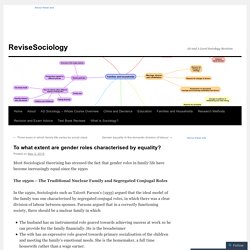
Parsons argued that in a correctly functioning society, there should be a nuclear family in which The husband has an instrumental role geared towards achieving success at work so he can provide for the family financially. Gender equality in the domestic division of labour. Do men and women do equal amounts of housework and child care today or is there evidence of a dual burden for women? What do the trends suggest about women’s empowerment? Issues of Power and Control in relationships. The Radical Feminist viewpoint is that relationships are the primary means through which men control women and maintain their power over them in society.
Probably the most shocking evidence which supports this view is the continued prevalence of domestic violence. According to the BCS (2007) this accounts for a sixth of all violent crime and nearly 1 in 4 women will experience DV at some point in their lifetime and women are much more likely to experience this than men. The radical Feminist explanation for DV is that it is an inevitable feature of a patriarchal society and it is part of a wider system that helps maintain male power over women, they key division in society. Just to demonstrate that this Radical Feminist views didn’t disappear in the 1980s – Here is a recent Radical Feminist view on domestic violence… “Domestic violence against women by men is “caused” by the misuse of power and control within a context of male privilege. (Women’s AID Domestic Violence Fact Sheet, 2009) 1. E-book available via Oliver. Functionalism (philosophy of mind) Since mental states are identified by a functional role, they are said to be realized on multiple levels; in other words, they are able to be manifested in various systems, even perhaps computers, so long as the system performs the appropriate functions.
While computers are physical devices with electronic substrate that perform computations on inputs to give outputs, so brains are physical devices with neural substrate that perform computations on inputs which produce behaviors. An important part of some accounts of functionalism is the idea of multiple realizability. Since, according to standard functionalist theories, mental states are the corresponding functional role, mental states can be sufficiently explained without taking into account the underlying physical medium (e.g. the brain, neurons, etc.) that realizes such states; one need only take into account the higher-level functions in the cognitive system. Mental state M is the state that is preconceived by P and causes Q. The Interactionist Perspective. Sociology of Gender – The Other Sociologist.
This page is a resource explaining general sociological concepts of sex and gender. The examples I cover are focused on experiences of otherness. In sociology, we make a distinction between sex and gender. Sex are the biological traits that societies use to assign people into the category of either male or female, whether it be through a focus on chromosomes, genitalia or some other physical ascription.
When people talk about the differences between men and women they are often drawing on sex – on rigid ideas of biology – rather than gender, which is an understanding of how society shapes our understanding of those biological categories. Gender is more fluid – it may or may not depend upon biological traits. The sociology of gender examines how society influences our understandings and perception of differences between masculinity (what society deems appropriate behaviour for a “man”) and femininity (what society deems appropriate behaviour for a “woman”).
Masculinity Femininity Like this: Gender role definition: Free Sociology Dictionary: gender role defined. The modern family: Look how we've changed. The Institute Director, Professor Alan Hayes said the data collected over three decades showed an increase in divorce rates, a decline in marriage rates and family size, and a shift to double income families and paid childcare. "In the early eighties some people wondered whether the family would actually survive," Professor Hayes said. "The marriage rate was declining and more people were living together. 3. Gender role attitudes within couples, and parents' time in paid work, child care and housework. The modern Australian family. Gender stereotypes are still pervasive in our culture. It is astonishing that, in 2018, girls still grow up being treated very differently from boys through entrenched stereotyping and unconscious biases. Girls’ subject choices in school are one clear symptom of their unequal experiences.
One example is that four times as many boys as girls take physics, a subject seen as having value by universities and employers alike. As a society we have become inured to such disparities in choices and also to the deeper malaise it reveals. Gendered stereotypes are pervasive in our culture – ingrained by long-standing biases (both conscious and unconscious). Young children must be protected from ingrained gender stereotypes. Scrolling through my Twitter timeline this week, one particular tweet, with an image attached, immediately jumped out at me. A parent had shared a snapshot of her six-year-old child’s homework – a worksheet asking pupils to research a scientist or inventor. So far, so normal. The Past, Present and Future of Gender Norms. What determines your destiny? Gender Data Portal.